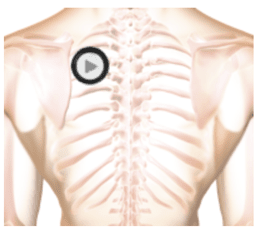Wheeze 647 Lesson
Where to Auscultate


The patient was seated during auscultation.
Description
Air flowing through a narrowed bronchus produces wheezes. Accordingly, these sounds will have their highest sound intensity when auscultating over or near the central airways.
Wheezes are adventitious lung sounds associated with secretions, obstructions, tumors, or airway compression. They are continuous sounds with a musical quality. High-pitched wheezes have a squeaking quality, while low-pitched wheezes are similar to snoring or moaning. The proportion of the respiratory cycle occupied by the wheeze roughly corresponds to the degree of airway obstruction.
Wheezes are also classified by when they appear in the respiratory cycle, e.g. inspiratory wheezing or a late expiratory wheeze, and by additional information about the sound quality (monophonic or polyphonic). These characteristics can be found in our Intermediate Lung Sounds module.
Phonocardiogram
Authors and Sources
Authors and Reviewers
-
Heart sounds by Dr. Jonathan Keroes, MD and David Lieberman, Developer, Virtual Cardiac Patient.
- Lung sounds by Diane Wrigley, PA
- Respiratory cases: William French
-
David Lieberman, Audio Engineering
-
Heart sounds mentorship by >W. Proctor Harvey, MD
- Special thanks for the medical mentorship of Dr. Raymond Murphy
- Reviewed by Dr. Barbara Erickson, PhD, RN, CCRN.
-
Last Update: 11/10/2021
Sources
-
Heart and Lung Sounds Reference Library
Diane S. Wrigley
Publisher: PESI -
Impact Patient Care: Key Physical Assessment Strategies and the Underlying Pathophysiology
Diane S Wrigley & Rosale Lobo - Practical Clinical Skills: Lung Sounds
- PESI Faculty - Diane S Wrigley
-
Case Profiles in Respiratory Care 3rd Ed, 2019
William A.French
Published by Delmar Cengage -
Essential Lung Sounds
by William A. French
Published by Cengage Learning, 2011 -
Understanding Lung Sounds
Steven Lehrer, MD
-
Clinical Heart Disease
W Proctor Harvey, MD
Clinical Heart Disease
Laennec Publishing; 1st edition (January 1, 2009) -
Heart and Lung Sounds Reference Guide
PracticalClinicalSkills.com